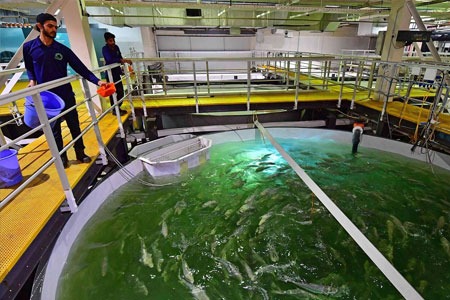
As urbanisation accelerates, the need for sustainable agriculture practices becomes more critical than ever. One innovative approach gaining traction is biofloc aquaculture. This method not only enhances fish production but also aligns perfectly with the principles of smart farming.
This innovative aquaculture technique enables urban farming enthusiasts and traditional farmers alike to maximise their resources while minimising environmental impact.
What is Biofloc Farming?
Biofloc aquaculture is a sustainable farming technique that involves cultivating fish in a controlled environment with the addition of beneficial microorganisms. These microorganisms convert waste products into protein-rich food, creating a self-sustaining ecosystem. This approach is especially beneficial for urban farming, where space is limited, and resource efficiency is paramount.
Key Features of Biofloc Farming:

In a world increasingly aware of environmental issues and health concerns, organic farming stands out as a beacon of sustainability
1. Microbial Floc Formation: The system encourages the growth of bacteria, algae, and protozoa, which aggregate to form “flocs.” These flocs serve as a food source for fish and shrimp.
2. Water Conservation: Biofloc systems require minimal water exchange, significantly reducing water usage compared to traditional aquaculture methods.
3. Nutrient Recycling: The microorganisms convert waste products (like ammonia) into microbial protein, thus improving feed conversion rates and reducing environmental pollution.
4. Space Efficiency: Biofloc farming is particularly suited for urban farming, as it can be implemented in small spaces or tanks.
5. High Yield Potential: This method can lead to increased growth rates and production, making it a viable option for meeting food demands.
6. Sustainability: Biofloc systems reduce water usage, making them ideal for urban settings where space is limited
7. Resource Efficiency: By recycling nutrients, biofloc farming minimizes feed costs and waste, aligning with sustainable agriculture practices.
How Biofloc Aquaculture Works

1. Tank Setup: Fish are raised in controlled tanks with good water circulation and aeration.
2. Microbial Floc Formation: Beneficial microorganisms grow and form aggregates (biofloc) that serve as food for the fish.
3. Waste Recycling: Fish waste (ammonia) is converted by microbes into less harmful substances, maintaining water quality.
4. Carbon Source Addition: A carbon source (like molasses) is added to promote microbial growth and nutrient balance.
5. Aeration: Continuous aeration keeps water oxygenated and suspends the biofloc for fish consumption.
6. Feeding: Fish receive high-quality feed and consume the microbial flocs, enhancing growth.
7. Water Quality Management: Regular monitoring ensures optimal conditions for fish and microbes.
8. Harvesting: Fish are harvested periodically, allowing the system to be continually productive.
Conclusion
Recent Posts
As we look to the future of farming, biofloc aquaculture stands out as a promising solution for sustainable urban agriculture. By embracing this innovative method, we can contribute to a more resilient food system that meets the needs of growing populations while safeguarding our planet. OrgaAyur productions promote smart farming technologies will only amplify these benefits, paving the way for a brighter agricultural future.
